

Stem cell culturet
supernatan treatment
Growth factors (cytokines) and exosomes promote the activation of weakened cells, repairing and regenerating damaged tissues and cells, bringing revolutionary effects in disease treatment, health maintenance, and beauty.
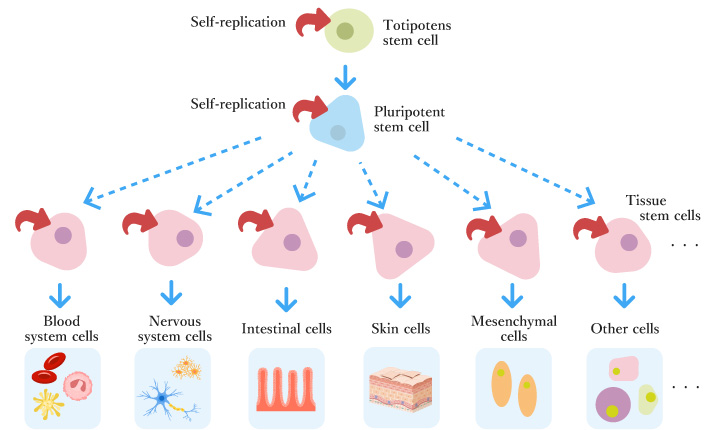
Do you know that our human body is made up of 60 trillion cells in order to maintain our body?
All tissues in the body, such as blood, bones, skin and organs, are made up of cells.
Cells are depleted and discarded day by day, new cells are born, constantly being reborn in the body.
All cells are not the same, and there are various types of cells depending on the body’s tissues and organs, and each cell plays a specific role.
This regeneration is supported by cells called “stem cells,” which constantly replenish new cells by dividing and differentiating.
Stem cells have two major characteristics: self-renewal ability and differentiation ability.
“Self-renewal ability” is the ability to repeat division and increase proliferation with the same shape and ability as yourself.
In a word, self-renewal allows the exact same stem cells to proliferate.
On the other hand, “differentiation ability” refers to the ability to create various cells necessary for building the body and has the ability to change into several different types of tissue cells such as vascular endothelial cells, nerve cells, and bone cells.
The application of these characteristics of stem cells is attracting attention as “regenerative medicine.
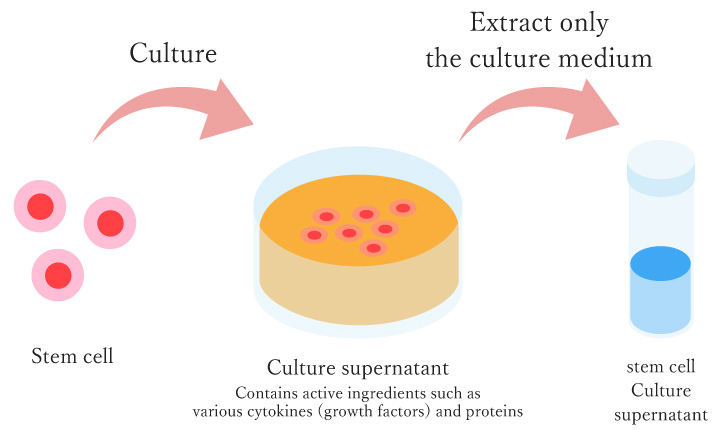
Stem cell culture supernatant is a supernatant solution made by extracting stem cells from the culture medium used for culturing stem cells, centrifuging the remaining culture medium, and subjecting it to sterilization.
Stem cells are cultured, activated during the process of proliferation, and release hundreds of humoral factors (growth factors, exosomes, etc.) into the culture medium.
Growth factors (cytokines) and exosomes promote the activation of weakened cells, repairing and regenerating damaged tissues and cells, bringing revolutionary effects in disease treatment, health maintenance, and beauty.
Adult stem cells include umbilical cord, bone marrow, dental pulp, and adipose-derived stem cells.
Among them, adipose-derived stem cells can be safely and easily collected in large quantities.
At our clinic, we use the stem cell culture supernatant to treat thinning hair by injecting it into the scalp or by Intravenous drip.
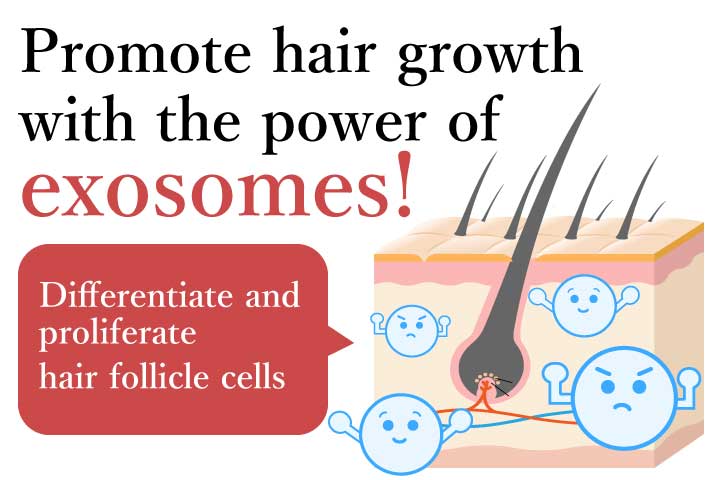
You often see the word “exosome” in beauty clinics and social media these days.
Stem cell culture supernatant contains growth factors and “exosomes,” and exosomes are capsule-shaped substances that are one of the components secreted from human cells.
They gather in injured cells and promote the activation of cells in the damaged area.
Although it is quite small, one millionth of a millimeter in size, there is a lot of information packed into that tiny capsule.
Exosomes secreted from cells are also present in body fluids (blood, spinal fluid, urine, etc.) and are said to play a role in transmitting information between cells.
In other words, exosomes can be said to be cellular messengers.
It travels throughout the body and transmits necessary information when something abnormal occurs, reinforcing damaged cells and their surroundings and encouraging the cells to recover on their own.
This action promotes the repair and regeneration of hair matrix cells, cell differentiation and proliferation, improves the scalp environment, and promotes hair growth.
This ability to deliver ingredients that promote hair regeneration to the hair roots, differentiate and proliferate hair follicle cells, and repair damaged hair follicles is also attracting attention in the field of hair loss treatment.
It is said to be effective for hair thinning symptoms such as AGA and FAGA, but it is not suitable for treating alopecia areata.
In addition, it is also said to be effective in improving skin spots, dullness, and pores, but it will not turn gray hair black.
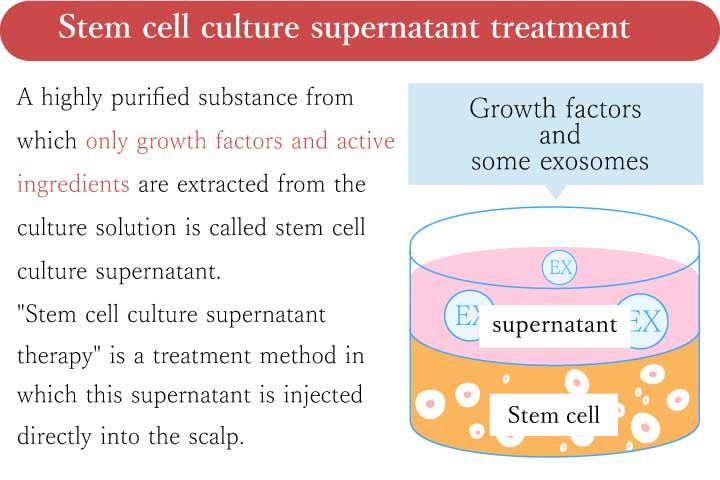
Stem cell culture supernatant contains exosomes, but not only exosomes.
In addition to exosomes, they also contain components such as cytokines (growth factors), hormones, extracellular matrix, and RNA.
This highly purified substance extracted from only cytokines and active ingredients is called “stem cell culture supernatant,” but it actually contains only a small amount of exosomes.
These growth factors and active ingredients promote the activation of weakened cells, repair and regenerate damaged tissues and cells, and can be expected to have hair growth and hair growth effects.
| Scalp injection | 1 time(1 vial | 88,000JPY |
|---|---|---|
| 3 time(1 vial) | 211,200JPY | |
| 5 time(1 vial) | 308,000JPY |
| Anesthetization | 0 JPY | |
|---|---|---|
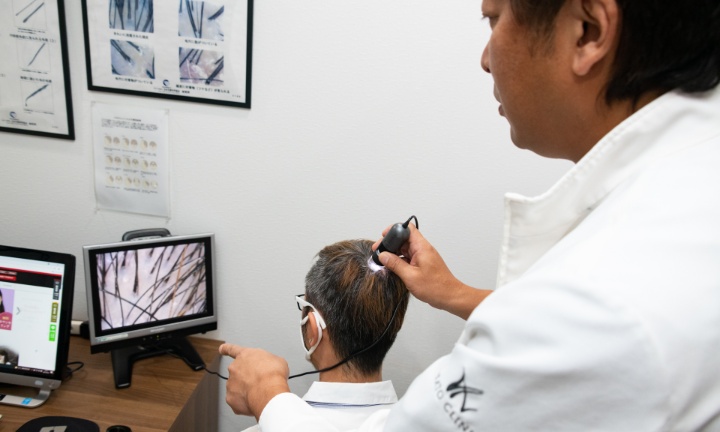
After about 10 minutes of counseling by the staff, the doctor will check the scalp, and explain the stem cell culture supernatant treatment.
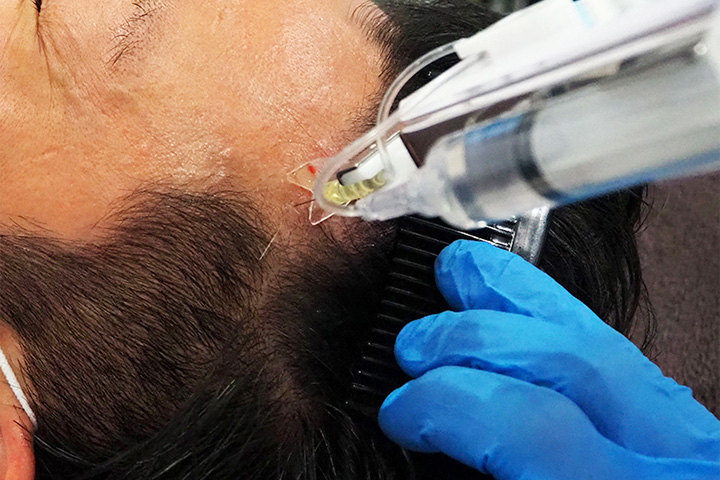
Doctor injects the stem cell into the scalp of the thinning hair part, it takes about 5 to 10 minutes.
Some bleeding will occur during the procedure.
There are individual differences in the amount of bleeding, but most people stop bleeding immediately.
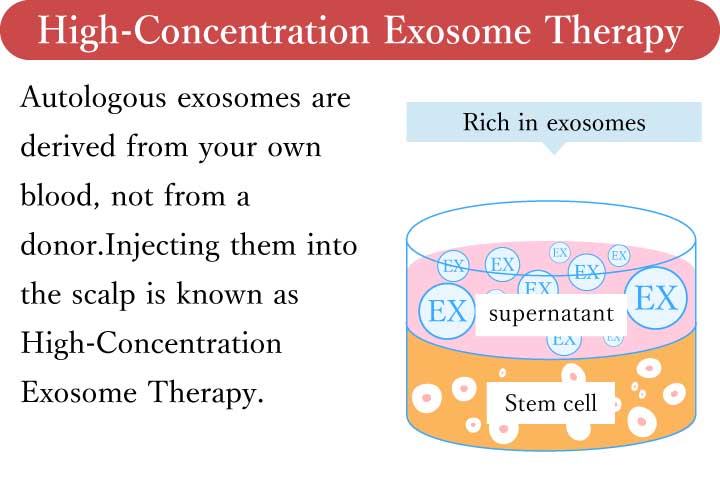
High-concentration exosome therapy is an advanced regenerative treatment that extracts and concentrates growth factors, exosomes, and other regenerative components from your own blood, then injects them into the scalp.
Unlike traditional PRP therapy, which mainly uses growth factors from platelets, this method also includes exosomes, miRNA, and other active elements—enhancing its effectiveness for hair growth and tissue repair.
At our clinic, we use a specialized system called “ExoSmart”, which efficiently collects these components, including exosomes released during platelet processing, creating a highly potent formulation.
This therapy uses autologous exosomes (from the patient’s own blood), minimizing the risk of allergic reactions and side effects.
Additionally, unlike standard PRP that discards PPP (Platelet Poor Plasma), we utilize it to maximize the concentration of beneficial factors.
| Scalp injection | 1 time | 286,000JPY |
|---|---|---|
| 2 times | 330,000JPY |

After about 10 minutes of counseling by the staff, the doctor will check the scalp, and explain the stem cell culture supernatant treatment.
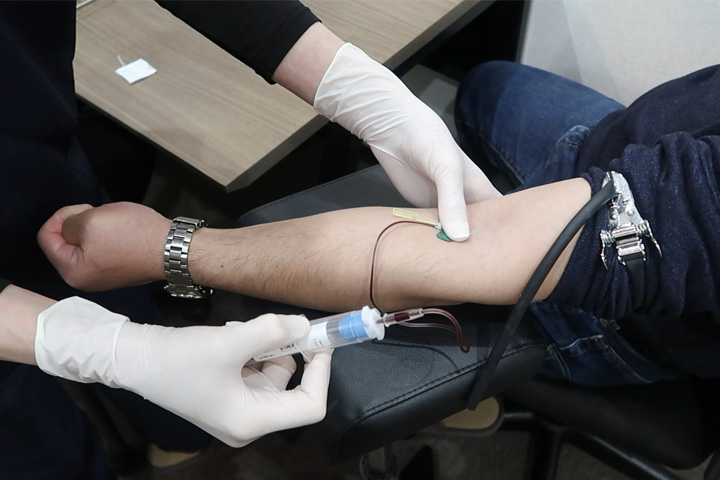
Approximately 40 ml of blood will be drawn to create your autologous exosome formulation.
Please come in on an empty stomach if possible, as it may help reduce discomfort.
If you are prone to feeling faint during blood draws or have a history of anemia or low blood pressure, please let our staff know in advance.
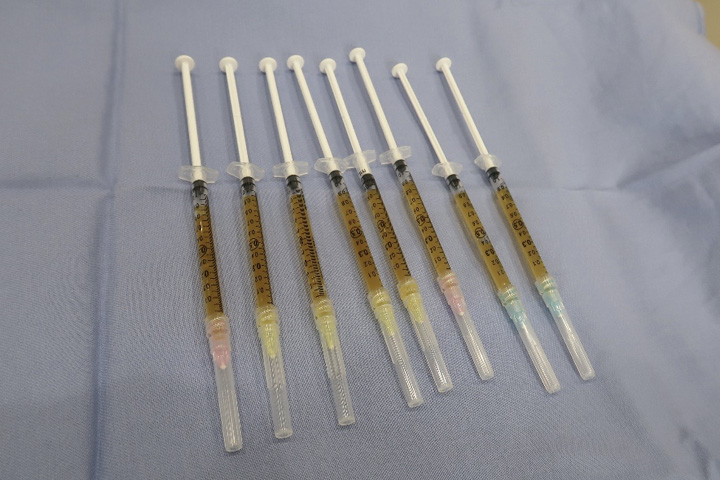
At our clinic, we use a specialized system called ExoSmart to extract autologous exosomes.
ExoSmart efficiently processes plasma that contains platelets, allowing us to concentrate valuable components such as autologous growth factors and exosomes from your blood.
During this process, platelets are activated, releasing a large amount of exosomes and regeneration-related factors.
This results in a highly concentrated formulation that may enhance tissue repair and stimulate hair growth.

The concentrated autologous exosome solution is injected into specific areas of concern on the scalp.
You can choose from the following injection methods:
■ Manual Injection
This method involves carefully injecting the treatment manually using a very fine needle.
It allows for deeper and more efficient absorption of the active ingredients.
However, since it may cause more discomfort, we perform a nerve block anesthesia beforehand to minimize pain.
■Automated Injector
This method uses a specialized device that delivers the treatment evenly at a consistent depth and speed.
It generally causes less pain, allowing most patients to undergo the procedure without anesthesia.
For those with low pain tolerance, we also offer numbing cream for added comfort.
| bFGF (Basic Fibroblast Growth Factor) | Gives signs of epidermal cell production to epidermal stem cells and promotes skin turnover (metabolism). It can be expected to improve stains and dullness. |
|---|---|
| aFGF(Acidic Fibroblast Growth Factor) | Stimulates and proliferates dermal stem cells (fibroblasts). It can be expected to have hair growth, hair growth promotion, anti-aging, wrinkle improvement, and whitening effects. |
| KGF(Keratinocyte Growth Factor) | It works on hair matrix stem cells to promote hair growth. By activating hair matrix cells during the hair growth period, hair growth and hair restoration effects can be expected. |
| VEGF(Vascular Endothelial Growth Factor) | It plays an important role in angiogenesis (branching and extending from existing blood vessels to form blood vessels). A hair growth effect can be expected due to the new formation of capillaries. |
| TGF-β(Transforming Growth Factor -β) | It has an anti-inflammatory effect, etc., and promotes proliferation and new generation of epithelial cells and vascular endothelium. In addition, since it promotes collagen production and strengthens the action of elastin, it can be expected to improve sensitive skin. |
| IGF-1(Insulin-like Growth Factor-1) | By regenerating new skin cells and promoting the production of collagen, elastin, and hyaluronic acid, it regenerates the firmness and elasticity of the skin. In the hair cycle of hair, it can be expected to have a hair growth effect because it extends the period of the growth period and also affects the shortening of the regression period and the resting period. |
| PDGF(Platelet-Derived Growth Factor) | It stimulates stem cells involved in tissue repair, such as fibroblasts, adipose stem cells, and epithelial stem cells, and promotes division. Hair growth and hair restoration effects can be expected due to cell growth promotion, angiogenesis, and macrophage activation. |
| HGF(Hepatocyte Growth Factor) | HGF is a hepatocyte growth factor, and it works to improve the function of the liver. It is involved not only in the liver, but also in regeneration of tissues such as promotion of cell proliferation of skin cells, promotion of cell movement, induction of morphogenesis, and angiogenesis. |